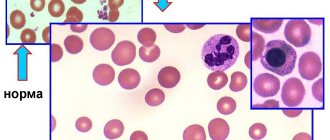Full text of the article:
Diabetes mellitus, or “sugar,” affects people of all ages. We have learned to live with this diagnosis and identify it in the early stages. However, the likelihood of early diagnosis of the disease is possible only with regular preventive examinations by a doctor. To begin with, we suggest you understand what diabetes mellitus can be.
Classification of pathology
Depending on the cause of the disease, there are 2 main types of diabetes mellitus: insulin-dependent (type 1) and non-insulin-dependent (type 2). In insulin-dependent diabetes, the pancreas does not synthesize insulin or produces it in insufficient quantities, and in non-insulin-dependent diabetes, tissue sensitivity to insulin decreases.
Additionally, a distinction is made between secondary diabetes (develops against the background of other diseases) and gestational diabetes (occurs in pregnant women).
Depending on compensation, diabetes mellitus is:
- compensated - carbohydrate metabolism is normalized, and glucose concentration approaches normal;
- subcompensated – blood sugar levels periodically increase or decrease;
- decompensated - neither diet nor medications can lower glucose, which is why diabetics often develop precoma or coma, which can lead to death.
To successfully compensate for diabetes, it is important to regularly measure blood sugar levels and make timely adjustments to treatment.
Prevention of type 2 diabetes
The most important thing is to remain positive and be ready for change. Try to wean yourself from possible bad habits and think about what gives you pleasure - this will help you move towards a healthier lifestyle. You can start walking more or try new, healthier recipes - whatever you like, as long as you do it with enthusiasm.
If you are in an age group at higher risk of developing diabetes or have a poor family history, there is no need to worry too much. Just check out this article and try to enjoy a healthy lifestyle.
Degrees of diabetes
According to the WHO classification, there are 3 degrees of the disease:
- mild (glucose level does not exceed 7 mmol/l) - often occurs hidden, symptoms are absent or barely noticeable, complications do not arise;
- moderate (sugar concentration - 7-14 mmol/l) - complications are observed in the form of damage to the skin, blood vessels, heart, kidneys, eyes, nerves;
- severe (glucose level is in the range of 15-25 mmol/l, and sometimes higher) - severe complications occur (diabetic ulcers, kidney failure, gangrene of the extremities, diabetic coma), and death is possible.
If the diagnosis is not confirmed
If the examination did not confirm the presence of diabetes, but identified factors for its development, then you need to be attentive to your health and not neglect prevention. Don't forget that prevention is always better than cure. Patients at risk are advised to follow a diet, lead an active lifestyle and have their blood glucose tested once a year.
If prediabetes is detected
Proper diet and lifestyle can help delay or prevent the onset of diabetes. Prediabetes indicates an early disorder of carbohydrate metabolism. Signs of prediabetes include impaired fasting blood glucose and impaired glucose tolerance. Patients are advised to consume less easily digestible carbohydrates and increase physical activity. In addition, it is recommended to be examined by a therapist at least once a year and have your blood glucose tested.
If you have been diagnosed with type 2 diabetes mellitus
Once the diagnosis of diabetes has been confirmed, treatment should not be delayed. First, you need to go to an appointment with an endocrinologist to clarify the concomitant pathology and select individual treatment. A referral to an endocrinologist will be given by a therapist or general practitioner if, as a result of the examination, it turns out that the level of blood glucose in venous plasma exceeds 7.0 mmol/l, and glycated hemoglobin is higher than 6.5%. The endocrinologist determines the individual target level of glycated hemoglobin (HbA1c) for the patient and develops glucose-lowering therapy based on the examination results and the presence of concomitant diseases.
Additional examinations
An endocrinologist may prescribe additional examinations for the patient. This is necessary to anticipate possible complications of T2DM. As an additional examination, the endocrinologist may refer the patient to an ophthalmologist to check the condition of the fundus and evaluate visual acuity at the time of diagnosis of type 2 diabetes.
There are a number of mandatory examinations that a patient with T2DM must undergo every year. These include ECG and chest x-ray. If indicated, the patient may be referred for additional examinations:
- See a cardiologist for arterial hypertension and dyslipidemia;
- See a nephrologist or urologist for kidney pathology;
- See a neurologist if you complain of loss of sensation in the limbs and poor wound healing.
Selection of treatment and free medications
The treatment program for the patient is drawn up by an endocrinologist. There is no standard program, since treatment is selected taking into account the patient’s lifestyle, the presence of concomitant diseases and a tendency to hypoglycemia. While the selection and correction of insulin therapy is underway, the patient should regularly visit an endocrinologist.
It is useful to know that patients with diabetes can receive preferential drug coverage; benefits apply to:
- hypoglycemic drugs and other medications prescribed by your doctor;
- means for administering insulin;
- means for self-monitoring of glycemia;
- consumables for insulin pump.
Medicines can be obtained with a prescription from a doctor. They are issued at the pharmacy of the clinic to which the patient is assigned. Prescriptions are issued for a period of no more than 90 days. If the drug is not available, the prescription is registered in a special journal in the prescribed form, and the drug is delivered to the point within 10 days.
Causes of the disease
The hereditary factor is of primary importance in the development of diabetes mellitus. Predisposition to the disease is transmitted through the maternal line in 5% of cases and through the father in 10% of cases. If both parents have diabetes, the risk of developing pathology reaches 100%.
Also, the main causes of non-insulin-dependent diabetes include:
- inactivity and overeating, leading to obesity - if body weight is 50% higher than normal, then the risk of increased glucose increases to 60%;
- poor nutrition.
The main causes of insulin-dependent diabetes:
- autoimmune diseases (lupus, autoimmune thyroiditis, glomerulonephritis, hepatitis);
- viral infections that destroy pancreatic beta cells responsible for the production of insulin (chickenpox, rubella, hepatitis, mumps).
Signs of the disease
The main symptoms and signs of diabetes are similar for both types of the disease:
- polydipsia - severe thirst;
- polyuria – frequent heavy urination, including at night (nocturia);
- Polyphagia – excessive appetite and constant hunger.
But there are also differences. For example, with type 1 diabetes, patients lose weight (despite a good appetite), and with type 2, they gain weight.
Diabetes mellitus in men is often accompanied by sexual problems: erectile dysfunction, early ejaculation, infertility.
Recommendations
Even in the absence of an established diagnosis of diabetes, it is recommended to monitor blood sugar once a year - this is the simplest and most accessible method of early diagnosis of the disease. There is no specific prevention of diabetes, so it is recommended to maintain a healthy lifestyle: rational exercise and proper nutrition.
In the case when this diagnosis is confirmed, constant contact between the patient and the doctor is necessary. Only under this condition is it possible to prevent the destructive effects of diabetes on the body.
Possible complications
In the absence of treatment or non-compliance with medical instructions, dangerous complications develop:
- diabetic ketoacidosis – accumulation of ketone bodies in the blood;
- hypoglycemia – a decrease in sugar concentration below normal (3.3 mmol/l);
- hyperosmolar coma – accompanied by severe dehydration;
- lactic acidotic coma - lactic acid accumulates in the blood and tissues;
- diabetic retinopathy – damage to the retina of the eye, leading to hemorrhages, possibly retinal detachment;
- diabetic macro- and microangiopathy – impaired permeability of blood vessels, increased fragility, tendency to thrombosis and atherosclerosis;
- diabetic polyneuropathy – damage to both parts of the nervous system (somatic and autonomic), which leads to pain in various parts of the body, deterioration of sensitivity and numbness of the lower extremities;
- diabetic nephropathy – kidney damage, eventually leading to kidney failure;
- diabetic arthropathy – pain and “crunching” in the joints, limited mobility of the limbs;
- diabetic ophthalmopathy - eye damage that contributes to the development of cataracts;
- diabetic encephalopathy – instability and sudden mood swings;
- diabetic foot – purulent-necrotic lesions of the foot, often leading to amputation.
It should be noted that the higher the blood glucose level and the longer the disease develops, the greater the risk of complications. Diabetics are 4-6 times more likely to develop malignant tumors. More than half of all amputations are caused by complications of diabetes mellitus.
Treatment methods
Currently, there is no way to eliminate the cause of the disease and completely cure diabetes mellitus. Therefore, diabetics are prescribed symptomatic treatment aimed at getting rid of unpleasant symptoms, maintaining stable glucose levels, normalizing body weight and preventing complications.
For type 1 diabetes mellitus, insulin therapy is prescribed, and for type 2 diabetes, sugar-lowering drugs are prescribed. Moderate physical activity and proper diet are important for successful treatment.
University
→ Home → University → University in the media → Modern classification and diagnosis of diabetes mellitus
The photo is for illustrative purposes only. From open sources
The relevance of changing approaches to the classification of diabetes mellitus (DM) is due to the variety of clinical manifestations and the need for a differentiated choice of treatment tactics. Work on this publication coincided with the final stage of preparation by the working group of national protocols for the diagnosis and treatment of diabetes, a working version of which is available on the website of the Republican Center for Medical Rehabilitation and Balneotherapy, which was used to indicate diagnostic criteria.
Approach navigator
Understanding diabetes as a syndrome of chronic hyperglycemia determines its diagnostic criteria, given in Table. 1.
The diagnosis of diabetes is established based on a combination of two laboratory indicators that meet the diagnostic criteria for diabetes:
- fasting blood glucose (two tests performed on different days);
- fasting blood glucose and HbA1c;
- blood glucose on an empty stomach and 2 hours after a load of 75 g of glucose or
- blood glucose in a random analysis in the presence of classic symptoms of hyperglycemia or dehydration and catabolism.
In case of newly diagnosed hyperglycemia against the background of a critical condition, to establish a diagnosis, it is necessary to evaluate HbA1c: an HbA1c level of >6.5% indicates in favor of diabetes.
Reasons for the need to use new classification approaches include:
- decreasing differences in the phenotypes of type 1 and type 2 diabetes as the prevalence of obesity in childhood and young adulthood increases;
- detection of type 1 diabetes in adulthood, including in association with autoimmune diseases;
- developments in the field of molecular genetics that make it possible to identify monogenic forms of diabetes.
In 1980, WHO proposed a well-known etiological classification of diabetes, which changes periodically. In recent years, there have been calls to update the classification system for diabetes because many patients did not fit into either type.
The accumulation of new data led to the fact that in 2021 the WHO updated the classification of diabetes, which is based on the etiopathogenetic principle. The proposed classification is based on the potential for use in real-life clinical practice, since many laboratory tests that can improve the differentiation of types of diabetes and improve the effectiveness of treatment are not available in most clinical settings worldwide. The classification of diabetes for 2021 is given in table. 2.
Diabetes mellitus type 1
Although type 1 diabetes has been called “childhood” or “adolescent” for many years, global trends indicate that 42% of type 1 diabetes occurs in people over 30 years of age.
Diagnostic criteria for type 1 diabetes:
- acute onset;
- presence and progression of clinical symptoms;
- ketonuria;
- young age;
- the presence of first-degree relatives with type 1 diabetes and/or autoimmune pathology in the patient.
If differential diagnosis is necessary, the diagnosis is confirmed by a reduced level of C-peptide and the detection of increased levels of diabetes-associated antibodies. Confirmation of type 1 diabetes determines the need for insulin replacement therapy (IT).
Diabetes mellitus type 2
It accounts for 90–95% of all types of diabetes, is most common in adults, but given the prevalence of overweight and obesity in children, there is an increase in the number of children with this disease.
Common characteristics include the combination of β-cell dysfunction with relative insulin deficiency and insulin resistance (IR) in the setting of overweight or obesity (predominantly visceral). The pathophysiological mechanisms of development of type 2 diabetes reflect different mechanisms, so it is likely that its subtypes will be defined in the future.
Type 2 diabetes often remains undiagnosed for many years due to oligosymptoms, but chronic hyperglycemia, which does not lead to noticeable symptoms of diabetes, determines an increased risk of cardiovascular pathology and microvascular complications.
Risk factors for developing type 2 diabetes:
- overweight or obesity;
- age over 45 years;
- family history (DM in first-degree relatives);
- arterial hypertension;
- presence of other cardiovascular diseases;
- hypercholesterolemia, hypertriglyceridemia;
- habitually low physical activity;
- birth of a child weighing >4 kg or evidence of a history of gestational diabetes;
- polycystic ovary syndrome.
The risk of type 2 diabetes is considered high if you are overweight or obese and have one (or more) other risk factors.
Clinical diagnostic criteria for type 2 diabetes:
- age 40 years and older;
- overweight or abdominal obesity;
- absence of ketonuria;
- family history of type 2 diabetes.
Due to oligosymptoms, diagnosis requires obtaining pathological laboratory data twice.
HbA1c is not recommended for anemia, hemoglobinopathy, hemodialysis, recent blood loss or after blood transfusion, treatment with erythropoietin.
An oral glucose tolerance test with a 75 g glucose load (OGTT) is performed when questionable glycemic values are obtained. OGTT is not performed:
- against the background of acute diseases;
- against the background of short-term use of medications that increase glycemic levels;
- with diagnosed diabetes or identified fasting glycemia of more than 7.0 mmol/l or random hyperglycemia of more than 11.1 mmol/l.
For most people with type 2 diabetes, insulin treatment is not necessary but may be necessary to reduce hyperglycemia and prevent chronic complications. As a rule, patients receive treatment with oral glucose-lowering drugs, the action of which is aimed at various parts of the pathogenesis.
Hybrid forms of diabetes
The identification of this type (isolated for the first time) is a consequence of the difficulties in differentiating type 1 and type 2 diabetes. Based on the characteristics of clinical manifestations, hybrid forms of diabetes include:
- slowly developing immune-mediated diabetes;
- Type 2 diabetes, prone to ketosis.
A slowly developing form of autoimmune diabetes in adults was described as diabetes manifesting similarly to type 2 diabetes, but with proven signs of autoaggression (increased antibodies to glutamic acid decarboxylase (GAD), tyrosine phosphatase (IA-2), insulin or transporter 8 zinc (ZnT8)). This form of diabetes is called latent autoimmune diabetes in adults (LADA - Latent Autoimmune Diabetes of Adult), which is subject to critical reflection. It is important that the need for IT when making a diagnosis is not obligatory and it is possible to control the disease with lifestyle changes and oral medications.
In 2021, a consensus statement of experts on LADA was published, defining diagnostic criteria for the pathology:
- age over 30 years;
- history of the presence of autoimmune pathology;
- the rarity of identifying components of the metabolic syndrome and the absence of cardiovascular diseases;
- the decrease in C-peptide levels is slower than in diabetes;
- positive GAD antibodies (the most sensitive marker) and other diabetes-associated antibodies;
- does not require IT when manifesting diabetes (Management of Latent Autoimmune Diabetes in Adults: A Consensus Statement From an International Expert Panel. Buzzetti R., Tuomi T. et al. Diabetes 2020, 69 (10) 2037-2047).
Confirmation of the diagnosis of LADA is carried out on the basis of the given algorithm and is based on determining the level of C-peptide in patients with positive GAD antibodies.
Shown in Fig. Algorithm 1 identifies patients with C-peptide levels between 0.3 and 0.7 nmol/L as patients with LADA.
Rice. 1
When C-peptide levels are 0.3–0.7 nmol/L, it is recommended to start treatment with dipeptidyl peptidase 4 inhibitors, sodium cotransporter 2 inhibitors, glucagon-like peptide 1 receptor agonists, or thiazolidinediones (non-sulfonylureas) (see Fig. 2). If target glycemic levels are not achieved, combination therapy can be used, and only when all possibilities have been exhausted is IT initiated.
Rice. 2
Discussions on the issue of slowly developing immune-mediated diabetes continue. The question of whether this condition is a separate disease or a stage of the process leading to type 1 diabetes remains open.
Type 2 diabetes prone to ketosis
An unusual form of ketosis-prone nonimmune diabetes was first described in young African Americans and later in other populations. The characteristic signs of the pathology are a combination of ketosis and signs of severe insulin deficiency with the development of remission and the absence of the need for IT for a fairly long time (up to 10 years), which resembles the course of type 2 diabetes. More often, this type of diabetes is detected in men and is not related to body weight. The main pathogenetic features of this disease are unclear.
Ketosis-prone type 2 diabetes can be differentiated from type 1 diabetes and classic type 2 diabetes. Glucotoxicity is considered to be a factor causing acute and recurrent β-cell failure. Restoring normoglycemia after initiation of IT leads to optimization of the secretory function of β-cells and eliminates the need for IT.
Other specific types of diabetes
Specific diabetes is a group of heterogeneous diseases characterized by a syndrome of chronic hyperglycemia caused by absolute or relative deficiency of insulin with dysfunction of vital organs and systems, with the exception of other types of diabetes included in this classification (see Table 3).
Monogenic forms of diabetes are based on the identification of a pathological mutated gene, which leads to the development of clinical manifestations. The diagnosis can only be reliably established based on the results of genetic testing. The listed variants of monogenic forms of diabetes include familial forms (MODY - maturity onset diabetes of the young) with early onset (before the age of 25 years), which is insulin-independent and occurs as a result of β-cell dysfunction. The most common genetic subtypes are associated with mutations in the glucokinase gene (GCK MODY) and the hepatonuclear factor gene (HNF1α MODY and HNF4α MODY).
Phenotypic manifestations and responses to treatment in different forms of monogenic diabetes vary. For example, with GCK MODY, lifelong mild fasting hyperglycemia persists with rare complications and does not require pharmacotherapy. The most common form, HNF1α MODY, on the contrary, leads to progressive and severe hyperglycemia with a high risk of vascular complications, but patients with this pathology remain highly sensitive to sulfonylurea derivatives.
Clinical manifestations are determined by the degree of decompensation of carbohydrate metabolism and the underlying disease. The most commonly recorded specific diabetes is caused by a pancreatogenic factor. Potential clinical manifestations include deafness, visual impairment with retinal atrophy, manifestations of encephalopathy, changes in appearance (growth disorders, elf-like face, pterygoid folds of the neck, large ears, micrognathia, lack of subcutaneous fat, impaired sexual development, acanthosis nigricans, etc. ). An assessment of family and drug history is obligatory. The form of specific diabetes is determined by anamnesis and examination confirming the presence of pathology that can cause diabetes. Treatment tactics are determined individually.
Unclassified diabetes
Conducting a full diagnostic search when identifying a disease aimed at clarifying the type of diabetes is becoming increasingly complex and is not always available in full, which has led to the inclusion of the category “unclassified diabetes.” Establishing this diagnosis is valid before establishing the cause of the pathology using anamnesis, examination and modern examination methods (presence or absence of ketosis or ketoacidosis, diabetes-associated AT, secretion of C-peptide, etc.).
Hyperglycemia first identified during pregnancy
It should be classified as diabetes diagnosed during pregnancy or as gestational diabetes (GDM), which is borrowed from the WHO publication “Criteria for the diagnosis and classification of hyperglycemia first identified during pregnancy” (2013).
The diagnosis of diabetes during pregnancy should be made if one or more criteria are present:
- fasting plasma glucose ≥7.0 mmol/L;
- plasma glucose level 1 hour after ingestion of glucose at a dose of 75 g ≥11.1 mmol/l;
- plasma glucose level ≥11.1 mmol/L at any time in the presence of symptoms of diabetes;
- HbA1c more than 6.5% in early pregnancy.
The diagnostic criteria for GDM are given in Table. 4.
The diagnosis of GDM can be established when one of the indicators increases after a load of 75 g of glucose.
In case of GDM and DM and pregnancy, only lifestyle correction and IT can be used as treatment options; all tableted antihyperglycemic drugs are contraindicated.
Conclusion
Obviously, the modern classification of diabetes is based on the potential assessment of new data on the characteristics of the development and treatment of diabetes and will be useful in real clinical practice. Tatyana Mokhort, Head of the Department of Endocrinology, BSMU, Doctor of Medicine. sciences, professor; Natalia Karlovich, chief physician of the Republican Center for Medical Rehabilitation and Balneotherapy, chief freelance endocrinologist of the Ministry of Health, candidate of medical sciences. Sciences Medical Bulletin, December 10, 2020








